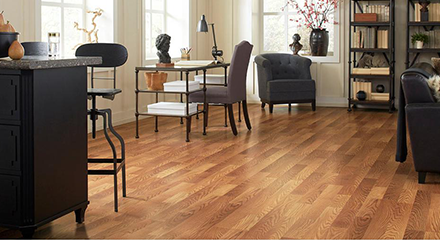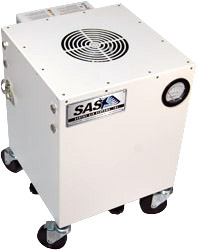If you were exposed to formaldehyde fumes in your workplace, your employer would be required to explain the risks to you and provide appropriate safety equipment. Why?
What is Formaldehyde?
Formaldehyde is a volatile organic compound (VOC). VOCs are chemicals that, due to their inherent qualities, vaporize readily at normal room temperatures. Formaldehyde, an industrial chemical with many uses in composite wood and polymer products, is considered by NIOSH, the National Institute for Occupational Safety and Health within the Centers for Disease Control and Prevention (CDC), to be a potential carcinogen as defined by OSHA’s carcinogen policy (29 CFR 1990).1 Since 2004, formaldehyde has been recognized as a known human carcinogen by the International Agency for Research on Cancer (IARC).2
The chart below summarizes workplace exposure limits for formaldehyde, however, none exist for inside the home. While there are many regulatory agencies interested in the regulation of formaldehyde in the home, there are currently no national standards in place designed to limit exposure to formaldehyde in the home.3
Formaldehyde Exposure Limits
| Organization | Time-Weighted Average (TWA) |
| OSHA Permissible Exposure Limit |
0.75 ppm |
| NIOSH Recommended Exposure Limit (REL) |
0.016 ppm |
| California Air Resource Board Composite Wood Products Regulation |
0.05 – 0.25 ppm |
TWA = 8-hour time-weighted average
Formaldehyde in Composite Wood Products
Wood products used in the home, such as laminated flooring and particleboard, as well as permanent-press draperies, may emit formaldehyde fumes. Formaldehyde fumes can make your eyes burn, make your head hurt, and cause allergic reactions.4 Recent revelations about the amount of formaldehyde in imported composite wood flooring made the news and caused corporate turmoil for the supplier.5,6
Formaldehyde Removal Testing
Because formaldehyde is used by our customers in many industrial, pharmaceutical and beauty industry applications, we asked a certified industrial hygienist to design a test to demonstrate how effectively our Model 300 Winged Sentry captures formaldehyde fumes.
Formaldehyde that escapes into the room air can be a health concern for personnel since it has poor warning properties and air concentrations could exceed the recommended limit before its odor is detected.7
Robert F. Adams
Industrial Hygienist
RF Adams & Associates
Two types of carbon filtration were tested, our standard activated carbon and our specially treated for aldehydes carbon. Activated carbon in the Model 300 Winged Sentry removed 95.45% of formaldehyde from the air.7 Specially treated carbon removed more than 96% of formaldehyde from the air.7
Chemisorption, the process that makes the treated carbon more effective than untreated carbon, is explained in this short [1:13] video by Ben, the friendly chemist.

Chemisorption and Customized Carbon Filters, one of 65 videos on Sentry Air’s youtube channel.
Formaldehyde Fume Control Solutions
Our lines of fume extractors are modular in design.
That means the same fan/motor chassis is used in our entire Model 300 line.
It also means filtration media, tested by industrial hygienists, offer the same performance characteristics and can be configured into any Model 300 fume extractor, even if their exterior contours differ.
Model 300 Portable Room Air Cleaner (PRAC)
It’s true our fume extractors are designed for industrial use.
Their reliability and tested capabilities are powerful allies in the home, too.
From basement to bedroom, the sturdy Model 300 PRAC rolls wherever you need it.
Whether your concerns are removing formaldehyde fumes, dust or allergens from your home’s air, our portable room clean cleaners can be configured with effective filters that are part of our standard catalogue.
Contact us today to protect your home or office from formaldehyde emisisons with composite wood flooring
Call us today at 1-800-799-4609
Update 7/26/19: As of December 12, 2016 – the EPA finalized the Formaldehyde Emission Standards for Composite Wood Products to restrict the emissions from composite wood products. Learn more here
Resources
1. Formaldehyde
http://www.cdc.gov/niosh/idlh/50000.html
2. IARC Classifies Formaldehyde As Carcinogenic To Humans
http://www.iarc.fr/en/media-centre/pr/2004/pr153.html
3. Questions and Answers Regarding Laminate Flooring
http://www2.epa.gov/formaldehyde/questions-and-answers-regarding-laminate-flooring-0#regulate composite wood
4. Formaldehyde in the home
http://www.arb.ca.gov/research/indoor/formaldgl08-04.pdf
5. Lumber Liquidators: The FEMA Trailer Formaldehyde Lawsuit Comparison
http://seekingalpha.com/article/3210356-lumber-liquidators-the-fema-trailer-formaldehyde-lawsuit-comparison
6. Lumber Liquidators’ Home-Testing Methods Get EPA Scrutiny
http://www.bloomberg.com/news/articles/2015-06-05/lumber-liquidators-formaldehyde-test-method-questioned-by-epa
7. Industrial Hygiene Report, Control of Formaldehyde in the Workplace
https://www.sentryair.com/testing/Formaldehyde.pdf
8. NIOSH Pocket Guide to Chemical Hazards
http://www.cdc.gov/niosh/npg/
9. NIOSH Pocket Guide to Chemical Hazards-Formaldehyde
http://www.cdc.gov/niosh/npg/npgd0293.html
10. Toxic and Hazardous Substance-Formaldehyde
https://www.osha.gov/pls/oshaweb/owadisp.show_document?p_id=10075&p_table=STANDARDS

 Made in the USA
Made in the USA

